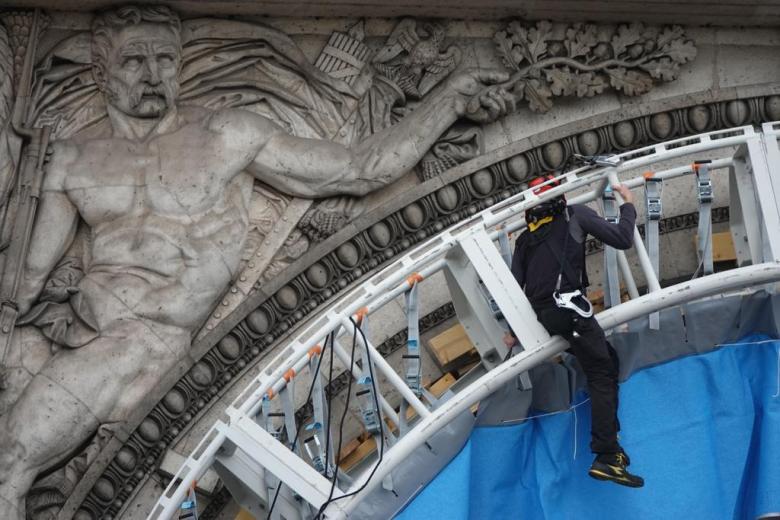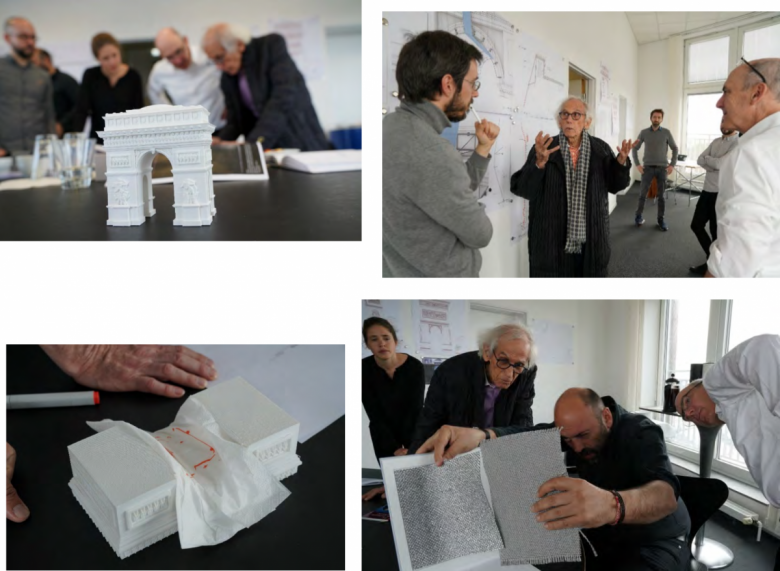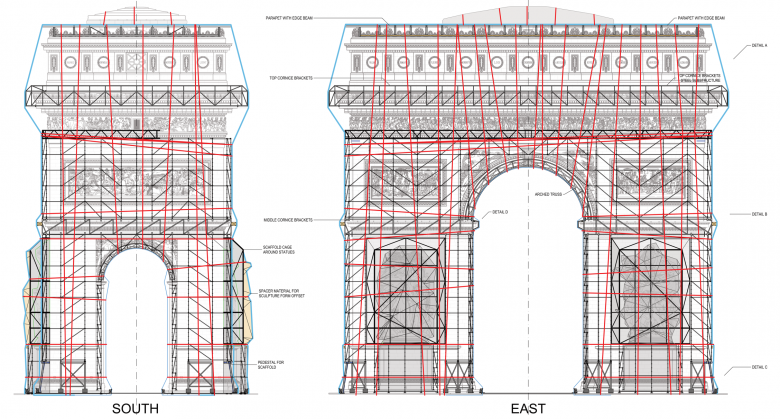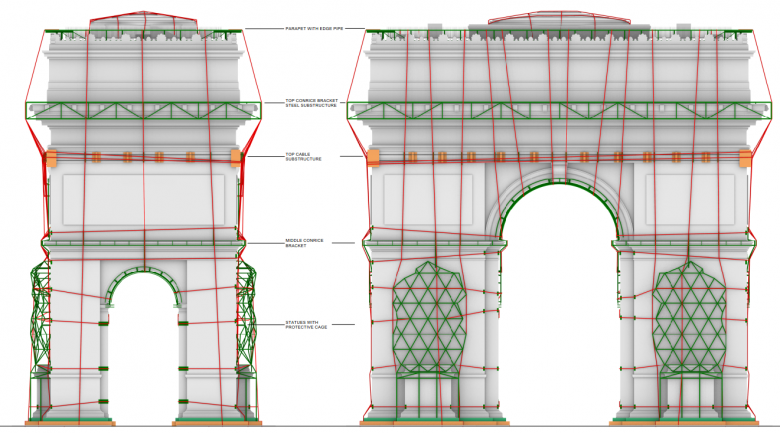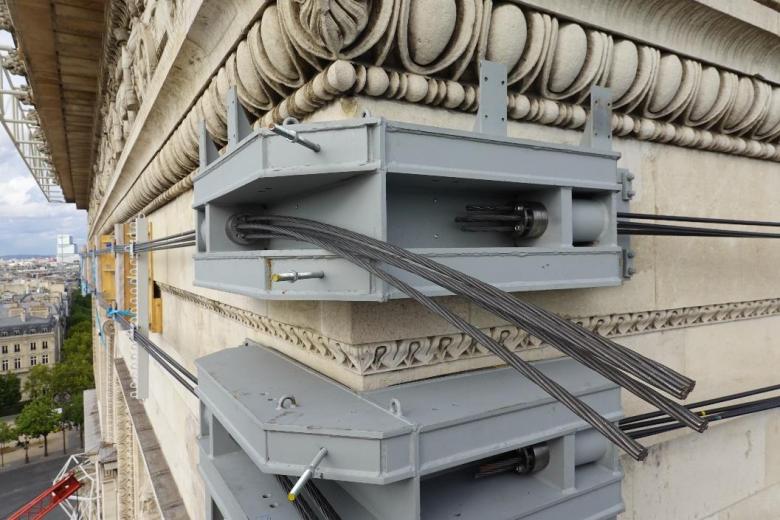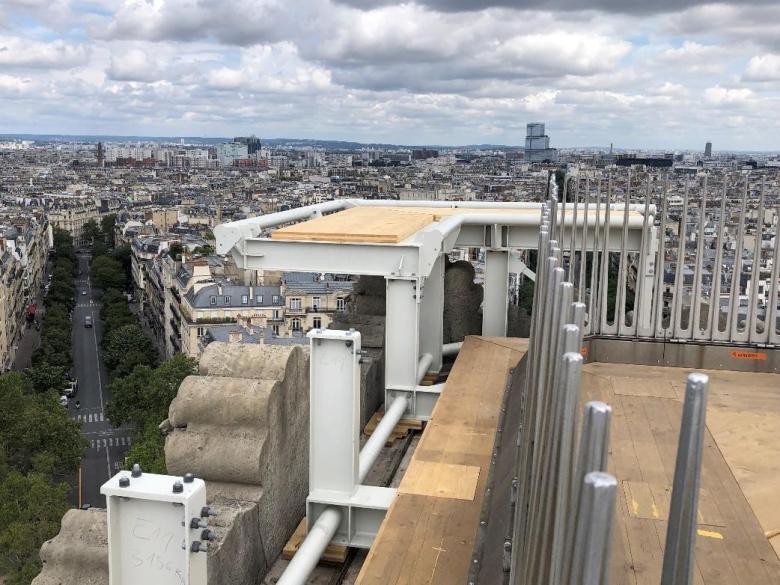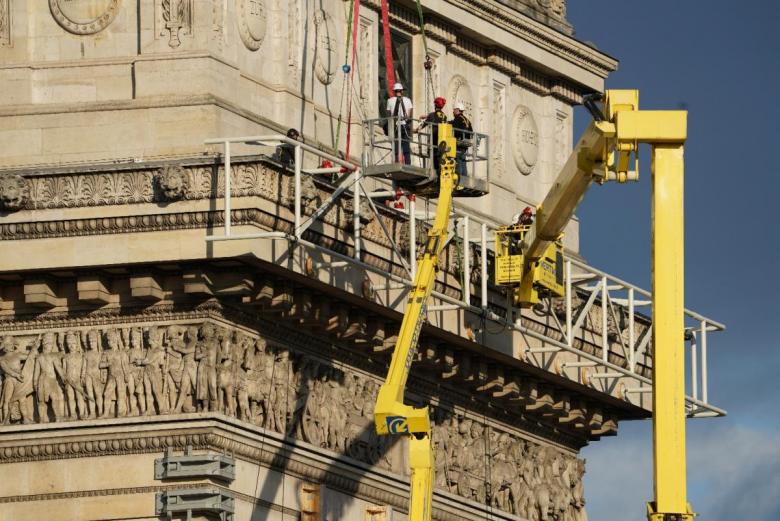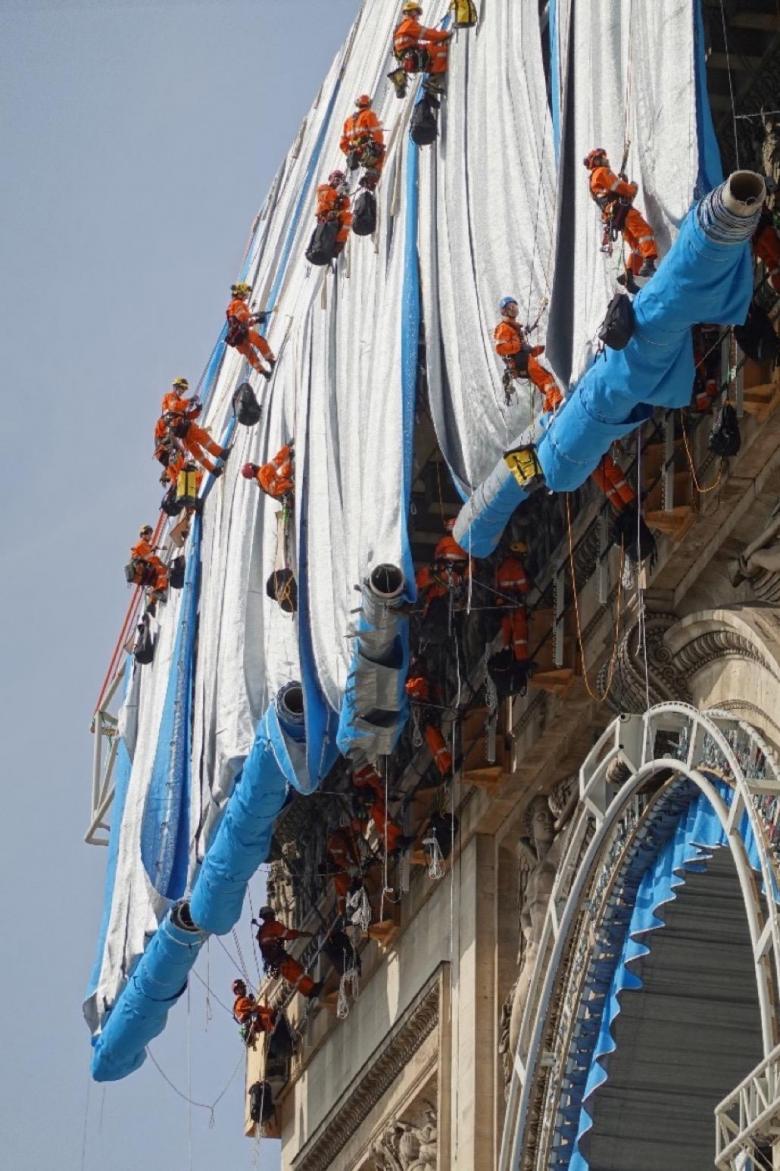"We strive for the total work of art"
Mike Schlaich on the Wrapping of the Arc de Triomphe
For a period of two weeks starting in late September, the Arc de Triomphe was only recognizable by its shape. Schlaich bergermann partner (sbp) implemented the wrapping project of the artist couple Christo and Jeanne-Claude in Paris. Katinka Corts spoke with Mike Schlaich on the engineering of the posthumous artwork by Christo and Jeanne-Claude.
Mr. Schlaich, like all projects, the wrapping of the Arc de Triomphe had a long lead time. The first drawings on canvas for this project were made as early as 1961, and it took 60 years until L’Arc de Triomphe, Wrapped could be realized for a period of two weeks. How did you and Christo come to work together?
The project originally goes back to a collaboration with Wolfgang Volz, the photographer who had always accompanied Christo and Jeanne-Claude and photographed their projects for books and collages since the 1970s. He also used to work for other clients and thus came into contact with the engineering firm Leonhardt, Andrä & Partner. For his first major photo job involving the documentation of bridges, Fritz Leonhardt had the young civil engineer Jörg Schlaich assist him — the beginning of a long-lasting relationship.
In 2007 and 2008, Christo and Jeanne-Claude commissioned professors from various universities to conduct feasibility studies for The Mastaba (Abu Dhabi). Subsequently, our engineering firm schlaich bergermann partner was entrusted with the analysis of these reports. We elaborated the best study for the preliminary project and have been closely associated with Christo’s team ever since; we were also involved in the small version of The Mastaba, on display at Hyde Park in 2018. It became customary for us to design the load-bearing structures for the team, so we were naturally delighted when they contacted us about the Paris project.
Yes, indeed. When we worked with Christo and Jeanne-Claude, we never followed award procedures or evaluation matrices, instead we always worked from a gut feeling. We supervised the project from Berlin because we had already worked on The Mastaba from there and the team was well attuned. Of course, it was a great advantage that we also have an office in Paris and there were always people on site for meetings.
As you already mentioned, L’Arc de Triomphe, Wrapped looks back on a long history. When Christo was approached in 2018 about doing an exhibition on the works of Christo and Jeanne-Claude at the Centre Pompidou, he agreed — on the condition that the Arc de Triomphe could also be wrapped. This coincided with the almost 200-year-old monument being vandalized during the Yellow Vests protests, and French President Emmanuel Macron seemed to have liked the idea of incorporating the monument into an art project. We then engaged in planning work for two years, and realization was originally scheduled for the autumn of 2020. After Christo’s death in May 2020 and the emerging Corona pandemic, it was decided to postpone the project by one year.
As construction engineers, we go straight for the Arc de Triomphe — that’s why we were part of some discussions right at the beginning. Christo had to overcome several hurdles, but the incredible thing about Christo was his charisma, his ability to convince and his enthusiasm. All kinds of institutions were involved! There was the Comité de la Flamme, chaired by a senior military officer, and one thing was clear: no matter what we did, this ceremony had to remain possible every day. The Centre de Monument, which is in charge of the monuments, was involved, as was the administration of the Arc de Triomphe itself. Although this authority had an interest in the art installation because it generates publicity, the accessibility of the roof for visitors was not to be restricted. And, as with so many building projects, we also had to deal with a breeding pair of hawks, which is why we were not allowed to work on the monument at certain times of the year.
That’s true: you "only" have a piece of art to begin with and you know that fabric is supposed to go over something and be fixed with red ribbons. We didn’t even know the exact dimensions of the Arc de Triomphe! First, we had to think about how much fabric would be necessary. Although the plans were helpful for an initial study, we then had to go to the archives to find out, for example, where stone tiles and where solid stone had been used for construction. After all, we needed quite a few places where we could install dowels — for that we needed information about the load-bearing capacity, the stone, the compressive forces that could be absorbed. Since it was too risky to work on the basis of older plans, we had another precise 3D survey done with drones.
"That’s my definition of elegance: unpretentious beauty. I consider something elegant when it seems natural."
The easiest solution would have been to build a scaffold, that’s true. But it wasn’t the most beautiful one. It quickly became clear that the red ropes Christo wrapped around the fabric in his picture would never be strong enough to withstand the loads. For comparison: the sail area of the three-masted barque Gorch Fock is 1,800 m2; for the Arc de Triomphe we are talking about 25,000 m2 of fabric. Just like on a sail, wind draws on a covering, and these wind suction forces are to be taken seriously! The fabric used in Paris is a polypropylene fabric with a weight of about 600 gr/m2, as was used for the wrapping of the Reichstag in 1995. In Paris, however, the membrane was to be blue and vaporized with aluminum powder.
We also had to find out what this fabric was able to withstand and how permeable it was to wind — this involved wind tunnel testing. Mounting the fabric on a scaffold would have been a quick way to do this — but that’s not really the way we work! Besides, we realized that the narrowest scaffolding would still be one meter wide, which would have pretty much changed the proportions of the Arc de Triomphe silhouette. Plus, mounting a scaffold securely to the structure would have required more than three times as many drill holes as we eventually needed for our implemented solution.
We engineer suspension and cable-stayed bridges and therefore know a lot about cables. So we started thinking about what we could do differently and came up with the idea of wrapping steel cables around the largest area of the structure, which you can’t see from the outside later on. We used spacers to prevent any damage to the monument. Where the big, thick Christo ropes cross each other on the outside, we connected the artistic ropes through the enveloping fabric to the supporting ropes of our construction. We tested these considerations on a 1:1.6 mock-up, which was located in a Paris suburb. Steel elements and wooden spacers were mounted at each of the four upper corners to pre-tension the ropes. The wind tunnel tests had already shown us that the fabric would lift significantly in strong winds. We pre-empted this lifting by pre-tensioning — thanks to the way the ropes are positioned and the parabolic pre-tensioning, the silhouette remains unchanged up to half of the wind load. At the same time, we wanted to make sure that the Arc de Triomphe would not be damaged by the extreme loads we assumed. For this reason, we rebuilt the construction on a test site; the already tensioned rope was pulled a further 50 centimeters away from the construction and then released. Fortunately, the construction withstood this as expected.
This construction allowed us to get so close to the outer contours of the monument that the silhouette of the Arc de Triomphe hardly changed when the fabric was finally lowered. Only in front of the large statues carrying swords and trumpets, we had steel cages mounted for protection. Two hundred tons of steel were necessary to construct the cantilevers at the top of the roof; in total, although it sounds like a lot, we used 400 tons of steel and drilled 200 boreholes in a minimally invasive way. The great advantage of steel construction is that it allows for prefabrication. With Les Charpentiers de Paris, our project manager Anne Burghartz had a timber and steel construction company at her side that prefabricated all the parts in just two months, so that in September construction and wrapping could finally be completed in just one week.
Christo always celebrated transience with his projects. Once all the works had been financed through the sale of pictures, they were almost completed. He always released the rights to market his projects, be it for photographic works such as posters and postcards or the coin machines where tourists could mint their souvenirs.
We won’t leave any traces on the structure itself; all the boreholes will be filled again. The membrane will be melted down except for a small part, and a basket of figures will be kept for a subsequent exhibition. The rest of the steel construction can be reused.
From an operational point of view, it was interesting and challenging to coordinate construction machinery, cranes and the work of industrial climbers in the middle of a huge roundabout. Every day, all of this was accompanied by the military, for whom we had built a small platform in the middle of the construction site for carrying out their ceremony. The site was also accessible to tourists at all times.
Yes, absolutely. You see, that’s my definition of elegance: unpretentious beauty. I consider something elegant when it seems natural. As if someone had thrown fabric over the Arc de Triomphe and tied it down. You don’t have to and shouldn’t be able to see the effort that went into the finished work. You can perhaps still feel it.
Thank you very much for the interview. Let’s now wait for the development of The Mastaba, which Christo began back in 1977. The construction and assembly process for it were also devised by sbp, and we can look forward to seeing if, how, and when this only permanent work of art by Christo and Jeanne-Claude will make its way into the world of Abu Dhabi.
In his research, he concerns himself with lightweight construction, currently mainly with the use of carbon materials for fatigue-proof, corrosion-free bridges and wide-span roofs, and with infra-lightweight concrete as load-bearing thermal insulation for monolithic fair-faced concrete structures that require no additional insulating materials. As part of his work as managing director of sbp, he is responsible for internationally award-winning bridge and building construction projects. He is co-author of the book Fußgängerbrücken - Konstruktion, Gestalt, Geschichte ("Pedestrian Bridges – Construction, Design, History"; in German only) and author of numerous publications.
Specialist planners involved in the project:
- Wood and steel construction: Les Charpentiers de Paris
- Construction ropes: Freyssinet
- Membrane planning: Ingenieur Tritthardt, Büro für Leichtbau
- Membrane fabrication: Robert Meyknecht, geo – die Luftwerker
This interview was originally published as "Mike Schlaich über die Verhüllung des Pariser Arc de Triomphe: 'Wir streben das Gesamtkunstwerk an.'" on German-Architects. Translation by Bianca Murphy.
